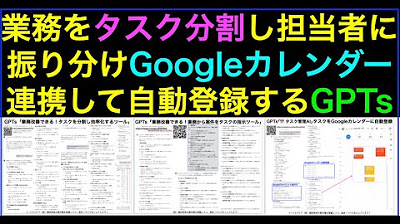How to Build a RACI Chart
Summary
TLDRThe RACI chart is a crucial project management tool that helps define roles and responsibilities for tasks. It stands for Responsible, Accountable, Consulted, and Informed. The video script explains how to create a RACI chart by listing tasks, identifying stakeholders, assigning roles, and checking for clarity and balance. It emphasizes the importance of communication and delegation, ensuring everyone knows their part in a project.
Takeaways
- 📊 **RACI Chart Importance**: The RACI chart is a critical project management tool, often used to define roles and responsibilities clearly.
- 🔍 **Terminology Evolution**: 'RACI' and 'Linear Responsibility Chart' are now used interchangeably, despite historical differences in meaning.
- 👤 **Roles Defined**: The acronym RACI stands for Responsible, Accountable, Consulted, and Informed, representing different roles individuals can have in a project.
- 🔑 **Accountability Key**: The 'Accountable' role is crucial as it ensures tasks have a single point of authority to avoid ambiguity.
- 📋 **Task Identification**: The first step in creating a RACI chart is to list all tasks or activities that need to be completed.
- 👥 **Stakeholder Inclusion**: Identify all stakeholders or team members and place them along the horizontal axis of the RACI chart.
- 📝 **Role Allocation**: Assign RACI roles to each stakeholder at the intersection of tasks and roles on the chart.
- 🔍 **Sense Check**: After allocation, conduct a sense check to ensure that every task has an accountable person and that workloads are balanced.
- 🗣️ **Consultation Essential**: Engage stakeholders to validate the RACI chart and incorporate their feedback to refine the chart.
- 📢 **Communication Tool**: The RACI chart serves as a communication tool, clarifying individual and team responsibilities within a project.
- 🔄 **Flexibility in Roles**: It's acceptable for individuals to have multiple roles or for some tasks to have shared accountability, as long as it's managed effectively.
Q & A
What is a RACI chart?
-A RACI chart is a project management tool that defines the roles and responsibilities of individuals or groups in a project. It is a matrix that typically has tasks along one axis and roles along the other, with the roles being Responsible, Accountable, Consulted, and Informed.
What is the difference between a RACI chart and a linear responsibility chart?
-Historically, a RACI chart had tasks and roles on the axes, while a linear responsibility chart had individuals along one axis and marked roles at the intersections. However, today the terms are often used interchangeably, with most people referring to the format where names are across one axis and tasks on the other.
What does RACI stand for?
-RACI stands for Responsible, Accountable, Consulted, and Informed. These are the four roles that individuals may take towards a task or activity on a project.
What is the role of 'Responsible' in a RACI chart?
-The 'Responsible' role is for individuals who are tasked with executing the work or performing the task.
What does 'Accountable' mean in the context of a RACI chart?
-The 'Accountable' role refers to the person who is ultimately responsible for the work being done. They have the authority to sign off on completion and are the final decision-maker.
Who are the 'Consulted' individuals in a RACI chart?
-The 'Consulted' individuals are those whose opinions matter regarding the task or activity. Their input is sought and considered in decision-making.
What is the purpose of the 'Informed' role in a RACI chart?
-The 'Informed' role is for those who need to be kept updated about the task or activity but do not have decision-making power or influence over the task's execution.
How do you create a RACI chart?
-To create a RACI chart, list all tasks, identify stakeholders, fill in roles for each stakeholder at each task intersection, perform a sense check, consult stakeholders, finalize the chart, and publish it.
What are the seven checks to perform on a RACI chart?
-The seven checks include: ensuring no tasks or stakeholders are missed, checking for accountability on every task, avoiding multiple accountable persons for a single task, ensuring no one has too much responsibility, verifying that every task has a responsible person, checking for tasks with too many responsible people, and assessing if too many people are being consulted.
Why is it important to consult stakeholders when creating a RACI chart?
-Consulting stakeholders helps ensure that the allocations of roles and responsibilities make sense from their perspective, allowing for feedback and adjustments to be made before finalizing the chart.
How does a RACI chart serve as a communication tool?
-A RACI chart communicates each individual's responsibilities and those of their colleagues, clarifying who is working on each task and in what capacity, which aids in coordination and understanding within the project team.
Outlines

هذا القسم متوفر فقط للمشتركين. يرجى الترقية للوصول إلى هذه الميزة.
قم بالترقية الآنMindmap

هذا القسم متوفر فقط للمشتركين. يرجى الترقية للوصول إلى هذه الميزة.
قم بالترقية الآنKeywords

هذا القسم متوفر فقط للمشتركين. يرجى الترقية للوصول إلى هذه الميزة.
قم بالترقية الآنHighlights

هذا القسم متوفر فقط للمشتركين. يرجى الترقية للوصول إلى هذه الميزة.
قم بالترقية الآنTranscripts

هذا القسم متوفر فقط للمشتركين. يرجى الترقية للوصول إلى هذه الميزة.
قم بالترقية الآنتصفح المزيد من مقاطع الفيديو ذات الصلة

Communicating and Working with Stakeholders | Google Project Management Certificate

How to Create a Gantt Chart in 9 Easy Steps

RESUMÃO - O que é o Gráfico (Diagrama) de Gantt?

業務をタスク分割し担当者に振り分けGoogleカレンダー連携GPTs

Azure DevOps Boards for Project Managers / Analyst (VSTS/ TFS) for beginners - Step by Step.

Mekanisme Manajemen Proyek dalam Pengerjaan Tugas Proyek | Tugas Kelompok 9
5.0 / 5 (0 votes)
